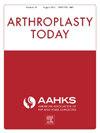Administration of a Methylprednisolone Taper and Complication Rates Following Total Knee Arthroplasty: A Multicenter Retrospective Study
IF 1.5
Q3 ORTHOPEDICS
引用次数: 0
Abstract
Background
Most patients undergoing total knee arthroplasty (TKA) report moderate to severe pain in the acute postoperative period. Recent preliminary data have suggested that a short course of oral corticosteroid may improve early postoperative pain after various orthopedic operations, but the safety of this practice has not been rigorously evaluated in larger patient populations. The purpose of this study was to evaluate complication rates in patients receiving a methylprednisolone taper (MT) vs controls after primary TKA.
Methods
Records were reviewed for patients undergoing primary TKA from 2018 to 2023 by 2 surgeons at different institutions who began routinely prescribing a 6-day MT to patients without a contraindication or poorly controlled diabetes. The primary outcome of periprosthetic joint infection at 90 days and final follow-up was assessed as were secondary outcomes of surgical site infection and wound complications. A total of 930 patients were included in the study, with 641 patients in the control cohort and 289 patients in the methylprednisolone cohort.
Results
There were no significant differences between the methylprednisolone and control cohorts in 90-day periprosthetic joint infection (0.7% vs 0%, P = .1, respectively), surgical site infection (1.0% vs 1.4%, P = .4, respectively), or wound complication (1.0% vs 2.0%, P = .4, respectively). There were no significant differences in any complication at final follow-up.
Conclusions
MT following TKA did not significantly increase rates of wound complications or infections in this multi-institutional retrospective cohort study. This study provides preliminary evidence regarding the safety profile of a short duration of postoperative oral corticosteroids following TKA.
全膝关节置换术后甲泼尼龙锥度的使用和并发症发生率:一项多中心回顾性研究
背景:大多数接受全膝关节置换术(TKA)的患者在术后急性期报告中度至重度疼痛。最近的初步数据表明,短期口服皮质类固醇可以改善各种骨科手术后早期的术后疼痛,但这种做法的安全性尚未在更大的患者群体中得到严格评估。本研究的目的是评估原发性TKA后接受甲基强的松龙锥形治疗(MT)的患者与对照组的并发症发生率。方法回顾2018年至2023年不同机构的2名外科医生对无禁忌症或糖尿病控制不佳的患者进行的原发性TKA患者的记录,他们开始常规给患者开6天的MT。评估90天假体周围关节感染的主要结局和最终随访,以及手术部位感染和伤口并发症的次要结局。研究共纳入930例患者,其中对照组641例,甲基强的松龙组289例。结果甲强的松龙组与对照组在90天假体周围关节感染(0.7% vs 0%, P = 0.1)、手术部位感染(1.0% vs 1.4%, P = 0.4)、伤口并发症(1.0% vs 2.0%, P = 0.4)方面均无显著差异。在最终随访中,任何并发症均无显著差异。结论:在这项多机构回顾性队列研究中,TKA后的smt没有显著增加伤口并发症或感染的发生率。本研究为TKA术后短时间口服皮质类固醇的安全性提供了初步证据。
本文章由计算机程序翻译,如有差异,请以英文原文为准。
求助全文
约1分钟内获得全文
求助全文
来源期刊

Arthroplasty Today
Medicine-Surgery
CiteScore
2.90
自引率
0.00%
发文量
258
审稿时长
40 weeks
期刊介绍:
Arthroplasty Today is a companion journal to the Journal of Arthroplasty. The journal Arthroplasty Today brings together the clinical and scientific foundations for joint replacement of the hip and knee in an open-access, online format. Arthroplasty Today solicits manuscripts of the highest quality from all areas of scientific endeavor that relate to joint replacement or the treatment of its complications, including those dealing with patient outcomes, economic and policy issues, prosthetic design, biomechanics, biomaterials, and biologic response to arthroplasty. The journal focuses on case reports. It is the purpose of Arthroplasty Today to present material to practicing orthopaedic surgeons that will keep them abreast of developments in the field, prove useful in the care of patients, and aid in understanding the scientific foundation of this subspecialty area of joint replacement. The international members of the Editorial Board provide a worldwide perspective for the journal''s area of interest. Their participation ensures that each issue of Arthroplasty Today provides the reader with timely, peer-reviewed articles of the highest quality.
 求助内容:
求助内容: 应助结果提醒方式:
应助结果提醒方式:


